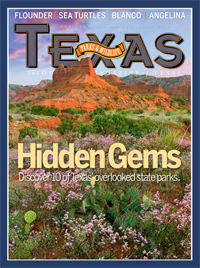
Flora Fact: Knobby Knees
Ancient bald cypress trees offer shade and useful building material.
By Karen H. Clary
Nothing beats the shade of a majestic bald cypress tree on a hot summer day, especially if you are floating down a river looking up at one.
In Texas, bald cypress (Taxodium distichum) trees grow along freshwater rivers and in swamps from the Edwards Plateau east through the Pineywoods and south to the Gulf Coast. The roots produce those strange-looking conical “knees,” thought to help support the tree and perhaps aerate the submerged roots. Bald cypress swamp forests make a unique, incredibly beautiful and productive ecosystem.
The genus name, Taxodium, means “yew-like” in Greek, alluding to the feathery leaves that resemble yew tree leaves. The species name, distichum, refers to the way the leaves are arranged on two sides of the branches. In the fall, the tree goes “bald” when the leaves turn orange and drop from the tree.

Bald cypress along the Guadalupe River.
Bald cypress trees are among the oldest living group of trees on earth. Twenty million years ago, their ancestors grew across Europe, Asia and North America. Today, bald cypress trees grow only in the United States, where their native range peters out on the Edwards Plateau. A sister species, Montezuma cypress (Taxodium mucronatum), grows along the Rio Grande. Two Texas rivers, the Sabine and Sabinal, take their names from sabino, Spanish for cypress.
Bald cypress are among the biggest, tallest and longest-lived trees in Texas. Some have reportedly reached an age of 800 to 1,200 years. When young, they’re shaped liked Christmas trees, but as they age, the crown tends to open up and the branches lift skyward, forming a massive, lofty, overarching canopy. Bald eagles and ospreys take full advantage of the height of these trees to nest on the river.
The seeds are produced in woody cones and feed squirrels, wild turkeys, wood ducks and other waterfowl and wading birds. Cypress wood contains cypressene, an oil that renders the wood decay-resistant and durable. The wood has been a favorite for construction wherever it grows, especially for outdoor uses such as boats, dock pilings, siding and roof shingles.
Native Americans carved single log canoes from the trunks. Early European settlers used the lumber to build notched log cabins, sheds and barns. The remains of some cypress buildings can still be seen today in the Hill Country.
Related stories
Flora Fact: The Toothache Tree
Flora Fact: Eastern Cottonwood

